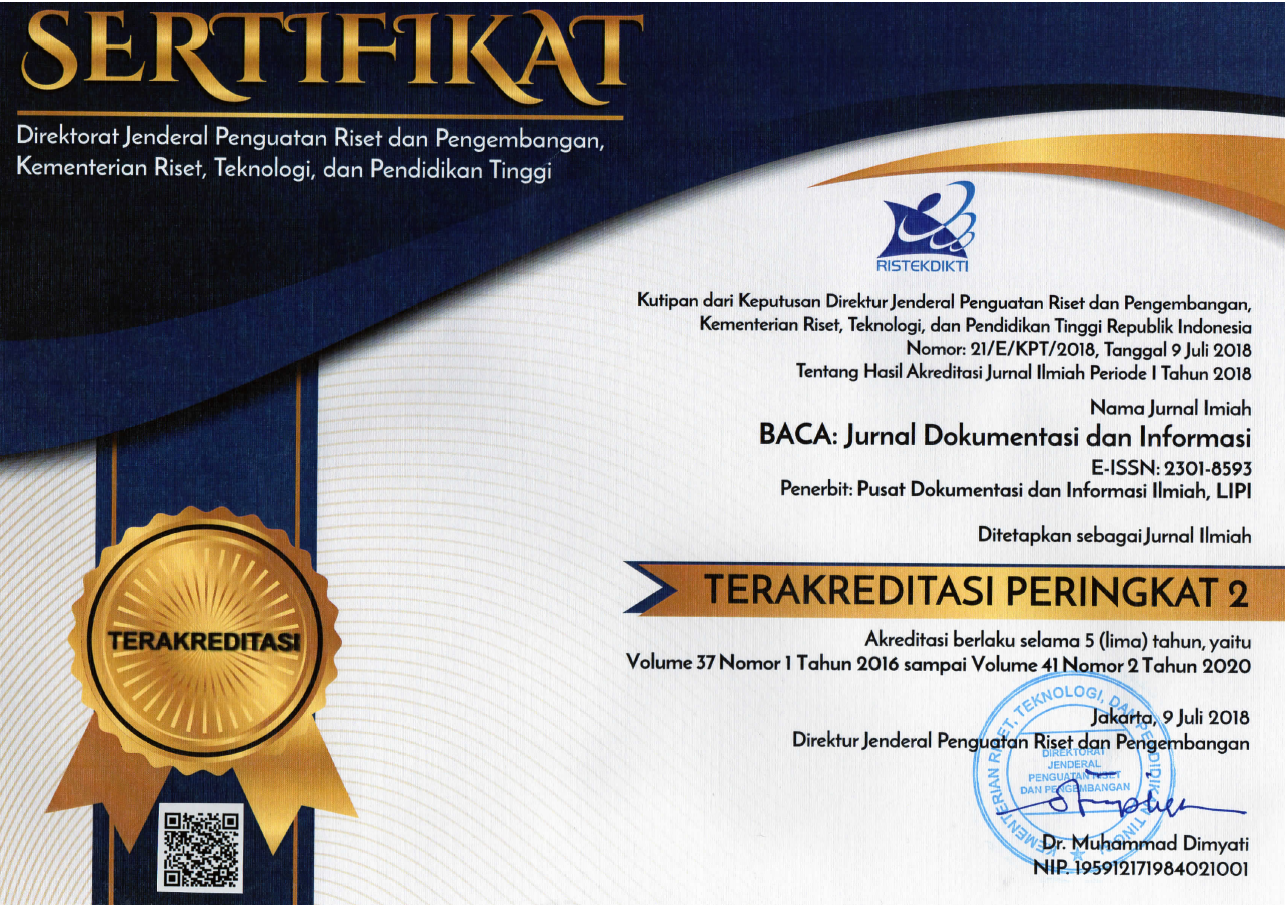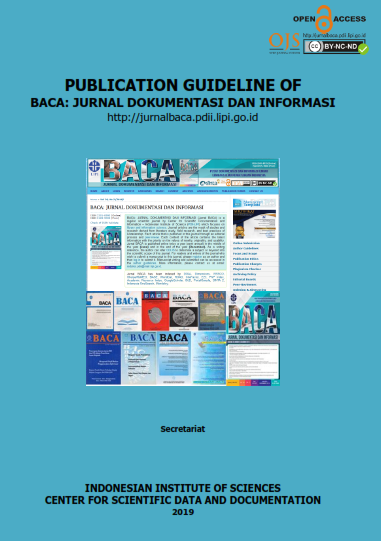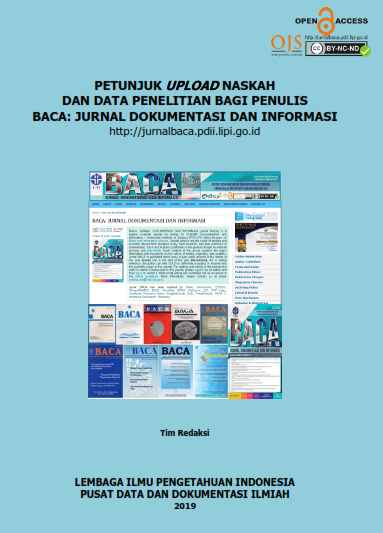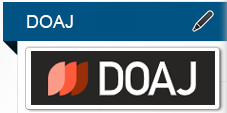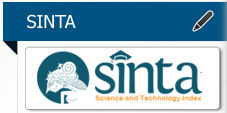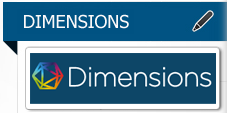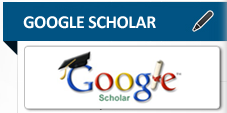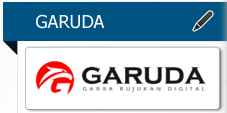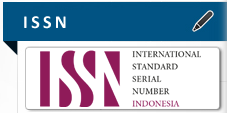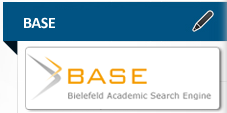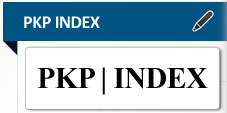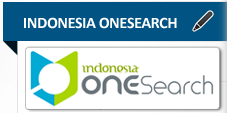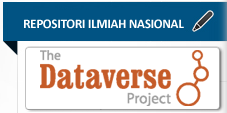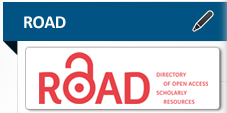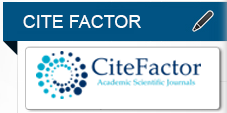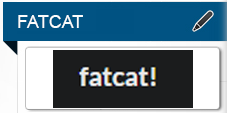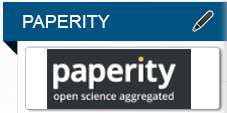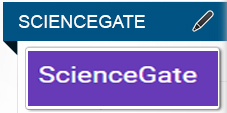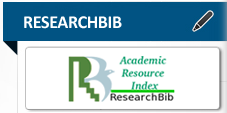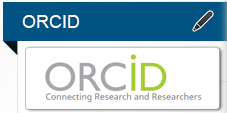HAMBATAN IMPLEMENTASI KOMUNIKASI ILMIAH AKSES TERBUKA: TINJAUAN SISTEMATIS
Abstract
Keywords
Full Text:
PDF (Bahasa Indonesia)References
Abraham, Juneman. (2020, September 26). Open access in Indonesia. Slideshare. https://www.slideshare.net/juneman/open-access-in-indonesia/.
Adrian, C., Abdullah, R., Atan, R., & Jusoh, Y. (2016). Towards developing strategic assessment model for big data implementation: A systematic literature review. International Journal of Advances in Soft Computing and its Applications, 8(3). http://www.i-csrs.org/Volumes/ijasca/ID13_-Pg173-192_SLR-Towards-Developing-Strategic-Assessment-Model.pdf
Devi, KS., & Lawanda, II. (2021). Individual and environmental factors correlate with information behavior of science and technology researchers in Indonesia. (submitted to Information Development).
DIKTI. (2019). Undang-Undang Nomor 11 Tahun 2019 tentang Sistem Nasional Ilmu Pengetahuan dan Teknologi. https://peraturan.bpk.go.id/Home/Details/117023/uu-no-11-tahun-2019
Fung, I. (2008). Open access for the non-English-speaking world: Overcoming the language barrier. Emerging themes in epidemiology, 5(1). https://doi.org/10.1186/1742-7622-5-1.
González-Betancor, S. M., & Dorta-González, P. (2019). Publication modalities “article in press” and “open access” in relation to journal average citation. Scientometrics. https://doi.org/10.1007/s11192-019-03156-2.
Hitchcock, S. (2013). The effect of open access and downloads (‘hits’) on citation impact: a bibliography of studies. [Project Report: University of Southampton]. https://eprints.soton.ac.uk/354006/
Ivwighreghweta, O., & Onoriode, O. K. (2012). Open access and scholarly publishing: opportunities and challenges to Nigerian researchers. Chinese Librarianship: an International Electronic Journal, 33. https://infojustice.org/archives/8950
Jonker, J. A. (2016). The impact of access problems on the information seeking behaviour of graduate students: a process study. [Tesis: University of Twente]. http://essay.utwente.nl/71031/
Kaba, A. K., & Said, R. (2015). Open access awareness, use, and perception: A case study of AAU faculty members. New Library World, 116(1/2). https://doi.org/10.1108/NLW-05-2014-0053.
Kitchenham, B., & Charters, S. (2007). Guidelines for performing systematic literature reviews in software engineering. EBSE Technical Report Version 2.3, EBSE-2007. https://www.elsevier.com/__data/promis_misc/525444systematicreviewsguide.pdf
Lwoga, E. T., & Questier, F. (2014). Faculty adoption and usage behaviour of open access scholarly communication in health science universities. New Library World, 115 (3/4). https://doi.org/10.1108/NLW-01-2014-0006.
Lukman. (2015). Aturan dan perkembangan jurnal elektronik. Makalah workshop kesiapan implementasi pengelolaan jurnal secara elektronik – LIPI, 26 Februari. PDII-LIPI.
MoChridhe, R. (2019). Linguistic equity as open access: Internationalizing the language of scholarly communication. The Journal of Academic Librarianship, 45(4), 423-427. https://doi.org/10.1016/j.acalib.2019.02.006.
Neto, S. C., Willinsky, J., & Alperin, J. P. (2016). Measuring, rating, supporting, and strengthening open access scholarly publishing in Brazil. Education policy analysis archives, 24(54), n54. https://eric.ed.gov/?id=EJ1100173
Okoye, M., & Ejikeme, A. (2011). Open access, institutional repositories and scholarly publishing: The role of librarians in South East Nigeria. Library Philosophy and Practice. https://core.ac.uk/download/pdf/188065346.pdf
Qayyum, R., Riaz, H., Rehman, A., Ahmed, B., Tahir, F., & Kazi, A.N. (2013). Open access publishing: Barriers, challenges and a window of opportunity. Journal of Pioneering Medical Sciences, 3, 160-161. https://www.jpmsonline.com/wp-content/uploads/2019/07/JPMS-VOL3-ISSUE4-PAGES160-161-SE.pdf
Salleh, N., Mendes, E., & Grundy, J. (2011). Empirical studies of pair programming for cs/se teaching in higher education: A systematic literature review. IEEE Transactions on Software Engineering, 37(4), 509–525. https://ieeexplore.ieee.org/abstract/document/5482588/
Shuva, N. Z., & Taisir, R. (2016). Faculty members’ perceptions and use of open access journals: Bangladesh perspective. IFLA journal, 42(1), 36-48. https://doi.org/10.1177/0340035216628879.
Seo, J., Chung, H., Seo, T., Jung, Y., Hwang, E., Yun, C. & Kim, H. (2017). Equality, equity, and reality of open access on scholarly information. Science Editing. 4. 58-69. https://doi.org/10.6087/kcse.97.
Suber, Peter. (2012). Open access. MIT Press.
Sultan, M., & Rafiq, M. (2021). Open access information resources and university libraries: Analysis of perceived awareness, challenges, and opportunities. The Journal of Academic Librarianship, 47(4). https://doi.org/10.1016/j.acalib.2021.102367.
Tennant, J. P., Waldner, F., Jacques, D. C., Masuzzo, P., Collister, L. B., & Hartgerink, C. H. (2016). The academic, economic and societal impacts of open access: An evidence-based review. F1000Research, 5. https://doi.org/10.12688/f1000research.8460.3.
Veletsianos, G & Kimmons. (2012). Assumptions and challenges of open scholarship. The International Review of Research in Open and Distributed Learning. 2012; 13(4): 166–189. https://doi.org/10.19173/irrodl.v13i4.1313.
Wahono, R. S. (2015). A systematic literature review of software defect prediction. Journal of Software Engineering, 1(1), 1-16. http://journal.ilmukomputer.org.
Ward, M. & Lavoie, J. (2016). A library-publisher partnership for open access: Building an innovative relationship between scholarly publishers and academic libraries. LIBER Quarterly. 25. 189. https://doi.org/10.18352/lq.10139.
Woszczynski, A. B., & Whitman, M. E. (2016). Perspectives on open access opportunities for Is research publication: potential benefits for researchers, educators, and students. Journal of Information Systems Education, 27(4), 259-276. https://aisel.aisnet.org/jise/vol27/iss4/5/.
DOI: https://doi.org/10.14203/j.baca.v42i2.827
Data citation
Devi, Katrin Setio; Rahmi, Rahmi, 2022, "HAMBATAN IMPLEMENTASI KOMUNIKASI ILMIAH AKSES TERBUKA: TINJAUAN SISTEMATIS", https://hdl.handle.net/20.500.12690/RIN/EF5NNK, RIN Dataverse, DRAFT VERSION
Copyright (c) 2022 BACA: JURNAL DOKUMENTASI DAN INFORMASI

This work is licensed under a Creative Commons Attribution-NonCommercial-NoDerivatives 4.0 International License.



